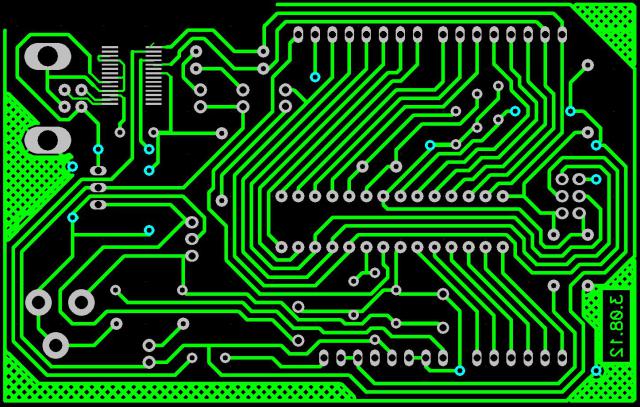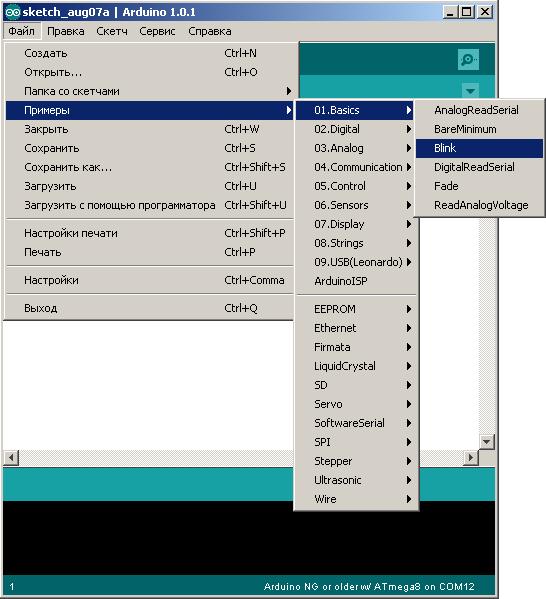Do it yourself Single-Side Arduino with a COM port on board
Being engaged in electronics and microcontrollers, I am well aware that it would be nice to have a ready-made debug board on hand. With its help, you can quickly check any servo, sensor, etc., or even assemble the entire project on it. That is why I decided to make Arduino myself.
The creators of the famous platform took care of DIY lovers and prepared for this a special one-sided version of the board . Also on the Internet there are very detailed instructions on how to make it at home . Unfortunately, this board has several drawbacks, namely: connecting only via the COM port and powered exclusively from the adapter. I decided to fix it and finally got this nice card:

Of course, the idea is not new, and on the Internet, the idea of screwing a virtual COM port to the Single-Side Board has repeatedly sounded, but I have never met a finished project.
Anyone who has ever dreamed of making Arduino for themselves on their own, please, under cat.
In the original board, I replaced the COM port with the FT232RL IC. It works with the TTL logic levels, so a converter (which in the original arduine is made with transistors) is not needed. To select a power source, a three-pin pinheader is provided on the circuit. It allows you to set the position of the jumper power source: USB port (position "int") or PSU connector (position "ext"). FTRL'ka always powered only from USB. There is also a “auto reset enable” jumper. Fundamentally I make responsible projects in P-CAD. Exporting graphics in it is quite complicated, so I post only screenshots of the drawings.

The board is almost completely stripped from the original, except for connecting FTRL'ki, a look through and through:

as well as an assembly drawing: I

recommend putting capacitors C7, C8 on its side so that they do not protrude above the connector.
DI HALT wrote better and more about how to solder something on his own . I’ll only add that problems may arise with FTRL wiring. I tried on the etched board to tin the pads under it - I almost tore it off. So I recommend soldering the conclusions one at a time. By the way, it is advisable to wash the circuit board from the flux: two times I saw such that after soldering the unwashed mikruha was not detected by the computer. If desired, the same LUT'om can be applied to the front side of the circuit board assembly drawing, but then it can no longer be washed in the bath with acetone.
When the board is made, you can do the software. First of all, you need to download and install the Arduino IDE's . as well as a driver for the FT232RL chip .
Now you need to flash the bootloader. Personally, I use such a programmer for firmware , do not consider it for advertising. You can read more about bootloader firmware here . The firmware file itself is on the hard drive at: C: \ Program Files \ arduino-1.0.1 \ hardware \ arduino \ bootloaders \ atmega8 \ ATmegaBOOT.hex. I just installed the controller in a ZIF socket and flashed this file directly. I took the fuse bits from here . It should be noted that I tried to run this board with the 168th mega, but I still could not do it. Most likely not a single bootloader came up.
Arduino programming is easy. We start the programming environment and select the board (in our case, it is Arduino NG or older w / ATmega8):

Then run the finished example, which blinks the user LED:

Next, click File-> Download and observe:
If everything is correctly assembled, it works right away. I found an error while loading - the output of Rx FTRLs was badly soldered, but I quickly fixed it.
In the archive you can take all the drawings, firmware, as well as a list of parts for purchase. Drawings are made in CAD P-CAD 2006. If someone helps to prepare files for LUT, I will be very grateful.
This board is fully arduino-compatible and allows you to work with standard shields and IDE's, although I rarely use them myself. In my opinion it is easier to assemble a project in AVR-studio - the old fashioned way))).
UPD:
The main article is now stored here .
The creators of the famous platform took care of DIY lovers and prepared for this a special one-sided version of the board . Also on the Internet there are very detailed instructions on how to make it at home . Unfortunately, this board has several drawbacks, namely: connecting only via the COM port and powered exclusively from the adapter. I decided to fix it and finally got this nice card:

Of course, the idea is not new, and on the Internet, the idea of screwing a virtual COM port to the Single-Side Board has repeatedly sounded, but I have never met a finished project.
Anyone who has ever dreamed of making Arduino for themselves on their own, please, under cat.
In the original board, I replaced the COM port with the FT232RL IC. It works with the TTL logic levels, so a converter (which in the original arduine is made with transistors) is not needed. To select a power source, a three-pin pinheader is provided on the circuit. It allows you to set the position of the jumper power source: USB port (position "int") or PSU connector (position "ext"). FTRL'ka always powered only from USB. There is also a “auto reset enable” jumper. Fundamentally I make responsible projects in P-CAD. Exporting graphics in it is quite complicated, so I post only screenshots of the drawings.

The board is almost completely stripped from the original, except for connecting FTRL'ki, a look through and through:

as well as an assembly drawing: I

recommend putting capacitors C7, C8 on its side so that they do not protrude above the connector.
DI HALT wrote better and more about how to solder something on his own . I’ll only add that problems may arise with FTRL wiring. I tried on the etched board to tin the pads under it - I almost tore it off. So I recommend soldering the conclusions one at a time. By the way, it is advisable to wash the circuit board from the flux: two times I saw such that after soldering the unwashed mikruha was not detected by the computer. If desired, the same LUT'om can be applied to the front side of the circuit board assembly drawing, but then it can no longer be washed in the bath with acetone.
When the board is made, you can do the software. First of all, you need to download and install the Arduino IDE's . as well as a driver for the FT232RL chip .
Now you need to flash the bootloader. Personally, I use such a programmer for firmware , do not consider it for advertising. You can read more about bootloader firmware here . The firmware file itself is on the hard drive at: C: \ Program Files \ arduino-1.0.1 \ hardware \ arduino \ bootloaders \ atmega8 \ ATmegaBOOT.hex. I just installed the controller in a ZIF socket and flashed this file directly. I took the fuse bits from here . It should be noted that I tried to run this board with the 168th mega, but I still could not do it. Most likely not a single bootloader came up.
Arduino programming is easy. We start the programming environment and select the board (in our case, it is Arduino NG or older w / ATmega8):

Then run the finished example, which blinks the user LED:

Next, click File-> Download and observe:
If everything is correctly assembled, it works right away. I found an error while loading - the output of Rx FTRLs was badly soldered, but I quickly fixed it.
In the archive you can take all the drawings, firmware, as well as a list of parts for purchase. Drawings are made in CAD P-CAD 2006. If someone helps to prepare files for LUT, I will be very grateful.
This board is fully arduino-compatible and allows you to work with standard shields and IDE's, although I rarely use them myself. In my opinion it is easier to assemble a project in AVR-studio - the old fashioned way))).
UPD:
The main article is now stored here .
